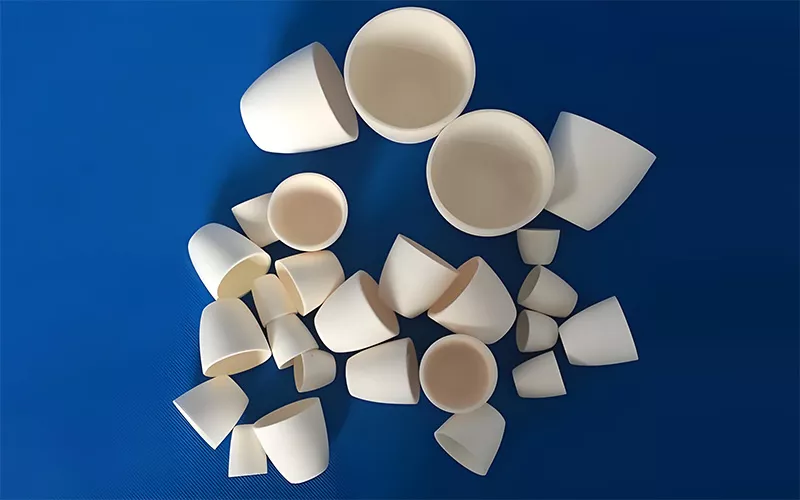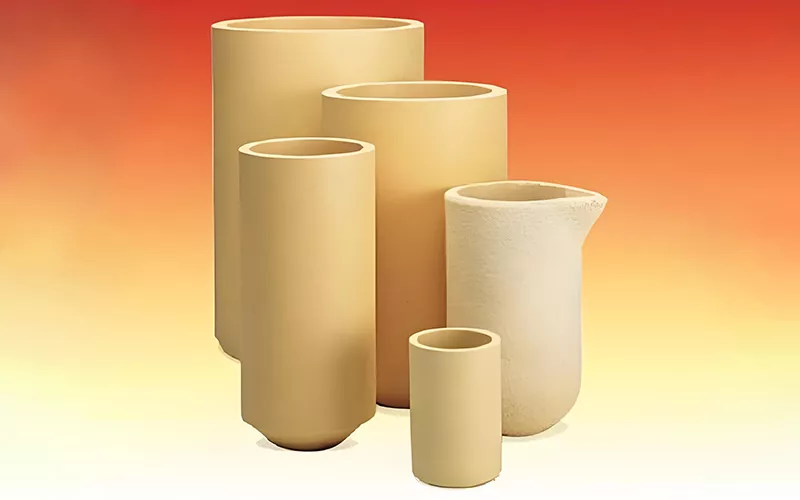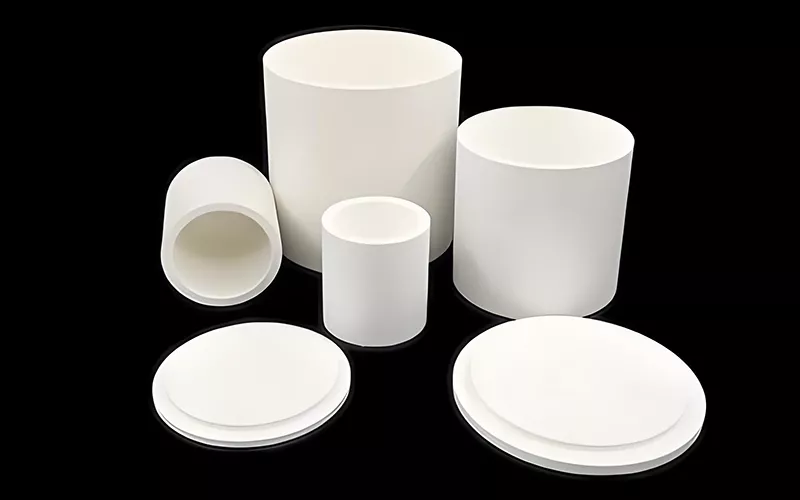Ceramic crucibles are containers with high melting points and high temperature resistance. They combine chemical stability with a low coefficient of thermal expansion, making them essential tools for extremely high-temperature applications in laboratories, metallurgy, semiconductor manufacturing, and other fields.
Ceramic crucibles are primarily made from advanced ceramics such as глинозем, нитрид бора, и оксид циркония. In this article, we’ll explore ceramic crucible material selection, key characteristics, and service life to help you select the most suitable crucible for your high-temperature application.

Из каких материалов изготовлен керамический тигель?
Алюминиевый тигель
Керамические тигли из оксида алюминия are primarily made of 99.7% pure aluminum oxide. Did you know? During the production process, many manufacturers, such as GORGEOUS, add small amounts of magnesium oxide (MgO) and silicon dioxide (SiO2) to impart superior physical and chemical properties to the crucibles.
Key Features: High-Temperature Resistance - Alumina crucibles can withstand temperatures of approximately 1700°C in a redox atmosphere. While offering superior performance, alumina crucibles are also price-competitive, making them the preferred material for many manufacturers.
Applications: Alumina crucibles are primarily used in laboratory and industrial metallurgy, heating, and chemical reactions.
Advantages: Alumina crucibles are one of the most economical ceramic crucibles on the market. Alumina’s high melting point and low thermal expansion coefficient make them resistant to cracking. They are ideal reaction vessels for weakly alkaline substances.
Limitations: Strongly corrosive substances, such as the strong base sodium hydroxide (NaOH), can severely damage alumina crucibles. For these materials, GORGEOUS recommends using a crucible material with strong corrosion resistance instead of alumina crucible.
Тигель из циркония
Zirconia crucibles are primarily made of high-purity zirconium oxide. Their exceptionally high temperature resistance and chemical stability make them ideal for extremely high-temperature melting processes.
Key Features: Zirconia crucibles boast robust high-temperature resistance, capable of withstanding temperatures up to 2000°C, making them ideal for melting precious metals such as platinum (Pt) and palladium (Pd).
Zirconium oxide also possesses excellent chemical resistance, maintaining a stable structure even in harsh environments with strong acids and alkalis, making it an ideal crucible material for processes prone to corrosion.
Applications: Zirconia crucibles are primarily used in precious metal melting and certain processes involving high-melting-point materials.
Тигель из закаленного циркониевого оксида алюминия (тигель ZTA)
Zirconia-toughened alumina crucibles (ZTA) are primarily made of 90% alumina and 10% zirconia. This ceramic material combines the advantages of both alumina and zirconia, offering excellent high-temperature resistance and high toughness.
Основные характеристики:
High Toughness - The addition of zirconia significantly improves the crucible’s crack and wear resistance, reducing damage caused by high temperatures and mechanical shock.
High-Temperature Resistance - ZTA crucibles can withstand temperatures up to 1700°C and operate stably in high-temperature environments.
Thermal Shock Resistance - Compared to pure alumina crucibles, ZTA crucibles offer higher thermal shock resistance, are more stable under severe temperature fluctuations, and are less prone to cracking.
Applications: These crucibles are primarily used in processes requiring high mechanical strength and high-temperature stability.
Тигель из нитрида бора (тигель PBN)
Boron nitride crucibles are specially designed for use at extremely high temperatures. Their primary component is pyrolytic boron nitride.
Основные характеристики:
High-Temperature Resistance - Boron nitride crucibles offer exceptional high-temperature resistance. In a protective atmosphere, they can reach temperatures of up to 2100°C and remain stable. They will not melt or react chemically with the substrate at extremely high temperatures.
Thermal Conductivity - Boron nitride crucibles have excellent thermal conductivity, allowing them to quickly dissipate heat, effectively preventing localized overheating, thermal stress, and thermal damage.
Low Thermal Expansion Coefficient - Boron nitride has a low thermal expansion coefficient, effectively reducing the risk of crucible cracking in high-temperature processes requiring rapid cooling or heating.
Applications: Boron nitride crucibles are primarily used in high-temperature processes such as semiconductor manufacturing and metal smelting. In the semiconductor industry, they are often used in chemical vapor deposition (CVD), crystal growth, and high-temperature evaporation.
Другие керамические материалы
В дополнение к обычным керамическим материалам, упомянутым выше, существуют также высококачественные материалы для тиглей, такие как оксид магния и оксид бериллия. Все они обладают превосходными высокотемпературными характеристиками и являются необходимыми материалами для контейнеров тиглей для многих плавильных цехов и лабораторий.
Как обеспечить срок службы тигля?
If you want your crucible to have better performance and service life, you’d better do the following:
Хранилище:
Лучше всего хранить использованные тигли в сухом и чистом месте, чтобы они не впитывали влагу и не загрязнялись. Следует избегать хранения тиглей вблизи химикатов или в местах с высокой влажностью.
Эксплуатация:
При работе с тиглем следует использовать соответствующие инструменты, избегать прямого контакта с руками и проверять его на наличие трещин и повреждений после использования.
Уборка:
После каждого использования необходимо тщательно очистить тигель. Все остатки следует удалить, а перед чисткой дать ему как следует остыть, чтобы избежать теплового удара и трещин.
Часто задаваемые вопросы
1. Что такое тигель?
Тигель — это контейнер, предназначенный для использования при чрезвычайно высоких температурах, в основном используемый для плавки металлов и химических реакций.
2. Какова температура плавления керамического тигля?
Температура плавления керамического тигля зависит в основном от используемого материала. Например, тигель из оксида алюминия может выдерживать температуры от 1650°C до 1700°C, а тигель из диоксида циркония может выдерживать температуры до 2000°C.
3. Каково применение керамических тиглей в химии?
Керамические тигли часто используются для высокотемпературной плавки металлов, в качестве контейнеров для химических реакций, контейнеров для обработки материалов и т. д.
4. Какова функция керамического тигля?
Керамический тигель в основном используется для высокотемпературного нагрева, плавления или рафинирования материалов и т. д. Он также может служить контейнером для некоторых химических реакций.
5. Каковы свойства материала керамических тиглей?
Керамические материалы обладают такими характеристиками, как высокая температура плавления, низкий коэффициент теплового расширения, хорошая термическая стабильность и стойкость к химической коррозии.
6. Можно ли использовать керамические тигли для плавки сильных щелочных веществ?
Это в основном зависит от материала тигля. Как правило, мы не рекомендуем использовать тигли из глинозема для плавки сильных щелочных веществ, таких как гидроксид натрия (NaOH) и перекись натрия (Na₂O₂), поскольку эти вещества могут разъесть тигель.
7. В чем разница между фарфоровым и керамическим тиглем?
Фарфоровый тигель обычно относится к тиглю, изготовленному из фарфорового материала. Керамический тигель имеет более высокие эксплуатационные характеристики, чем традиционный фарфоровый тигель, может выдерживать более высокую температуру и имеет более прочные механические свойства.
8. Как нагреть керамический тигель?
При нагревании керамического тигля следует выбрать подходящий метод нагрева в соответствии с характеристиками материала тигля. Следует отметить, что следует избегать резкого охлаждения или нагрева во время нагрева, что может привести к растрескиванию тигля.
9. Каковы методы обслуживания керамических тиглей?
После использования тигля его следует тщательно очистить, чтобы удалить остатки, а затем использовать подходящий чистящий раствор, после чего промыть его чистой водой и высушить для дальнейшего использования.
Заключение
Ceramic crucibles are indispensable tools in modern chemistry and metallurgy. Capable of operating in extreme temperatures and harsh chemical environments, they play a key role in a wide range of scientific and industrial applications. GORGEOUS, a leading international supplier of advanced ceramics, offers custom-made ceramic crucibles in a variety of materials. Thank you for reading this article, and we hope you find it helpful.